View in other NatureServe Network Field Guides
NatureServe
Montana
Utah
Wyoming
Idaho
Wisconsin
British Columbia
South Carolina
Yukon
California
New York
American Black Bear - Ursus americanus
Native Species
Global Rank:
G5
State Rank:
S5
(see State Rank Reason below)
Agency Status
USFWS:
USFS:
BLM:
External Links
State Rank Reason (see State Rank above)
Species is common and widely distributed. It is likely stable and faces no known significant threats.
General Description
Coat black (often with white on chest), brown or blond; slight shoulder hump, but highest point of body above hips; muzzle straight and long in profile; claws of front feet dark, strongly curved, and shorter (seldom more than 1 1/2 inches) than those of Grizzly Bear; males weigh 180-250 lbs., occasionally up to 400 lbs.; females weigh 120-180 lbs. Largly nocturnal; usually solitary; dig less elaborate dens than Grizzly Bears, often in natural cavities (trees, rocks), under logs, brush piles, or even buildings; climb trees easily (MTFWP 1992). Pelage color varies, usually black in the eastern U.S., black, brown, cinnamon, blue-black, or whitish in western North America; snout brown, straight in profile; small rounded ears; five toes on both front and rear feet; head and body length 150-180 cm, tail about 12 cm, mass about 90-140 kg for females, 115-270 kg for males (Burt and Grossenheider 1964, and Nowak 1991).
Diagnostic Characteristics
Differs from the Grizzly Bear in having the claws of the forefeet only a little longer than those on the hind feet (about twice as long in the Grizzly Bear), length of second upper molar less than 29.5 mm (in part of range where Grizzly Bear occurs), snout profile straight rather than dished, and in lacking a prominent hump at the shoulders; maximum size of American Black Bear is less than that of the Grizzly Bear (170-280 cm head and body length) (Hall 1981 and Nowak 1991).
Species Range
Montana Range
Range Descriptions
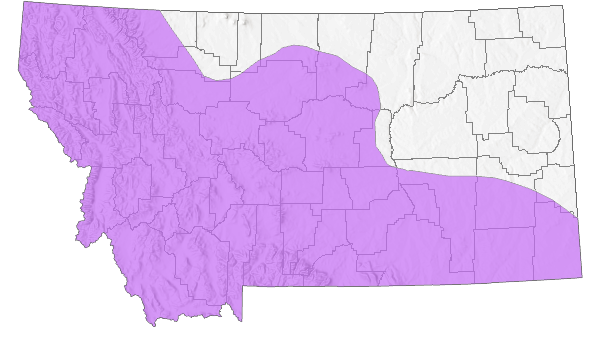
 Native
Native
Western Hemisphere Range
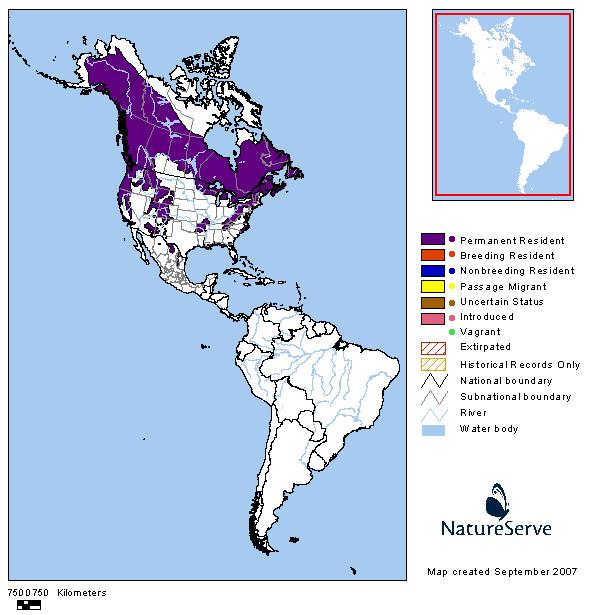
Observations in Montana Natural Heritage Program Database
Number of Observations: 2918
(Click on the following maps and charts to see full sized version)
Map Help and Descriptions
Relative Density
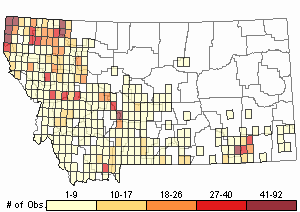
Recency
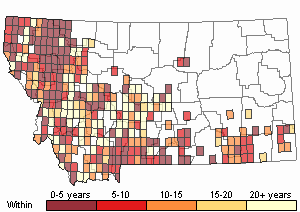
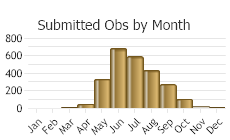
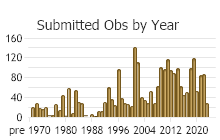
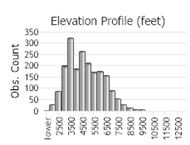 (Observations spanning multiple months or years are excluded from time charts)
(Observations spanning multiple months or years are excluded from time charts)
Migration
Non-migratory, but American Black Bears sometimes exhibit long distance movements.
Habitat
Dense forests; riparian areas; open slopes or avalanche chutes during spring green-up (MTFWP 1992). Habitat use tied to seasonal food availability/plant phenology. Dry mountain meadows in early spring; snow slides, stream bottoms, wet meadows in early and mid-summer. May concentrate in berry and whitebark pine areas in fall (Tisch 1961, Barnes and Bray 1967, and Jonkel and Cowan 1971).
National Vegetation Classification System Groups Associated with this Species
Forest and Woodland
Deciduous Forest and Woodland
Low Elevation - Xeric Forest and Woodland
Montane - Subalpine Forest and Woodland
Shrubland
Arid - Saline Shrubland
Foothills - Montane Shrubland
Sagebrush Shrubland
Grassland
Lowland - Prairie Grassland
Montane - Subalpine Grassland
Wetland and Riparian
Alpine Riparian and Wetland
Peatland
Riparian and Wetland Forest
Riparian Shrubland
Wet Meadow and Marsh
Recently Disturbed or Modified
Harvested Forest
Insect-Killed Forest
Recently Burned
Food Habits
Grasses, sedges, berries, fruits, inner bark of trees, insects, honey, eggs, carrion, rodents, occassional ungulates (especially young and domestic), and (where available) garbage (MTFWP 1992). Diet varies: Spring - primarily vegetation (grasses, umbels, and horsetails); summer - herbaceous and fruits; fall - berries, nuts, and some vegetation. Insects a frequent component of diet. Also mammals, birds, and carrion (usually minor) (Tisch 1961).
Ecology
Sympatric with Grizzly Bear but more prone to occupying closed canopy areas. Natural cub and adult mortality low, sub-adult mortality higher (Jonkel and Cowan 1971). American Black Bears sometimes involved in various crop/property depredations.
Reproductive Characteristics
Similar to Grizzly Bear, except females often first breed at 2 1/2 or 3 1/2 years of age; in very poor habitat, may not breed until 6 1/2 (MTFWP 1992). Estrus May 25 to August 10; peak in June. In NW MT first estrus at 4.5 years, often no litter until 6.5 years old. Average litter size 1.5 to 1.8 young/female. Litters every 2 to 3 years. Reproductive rates may be tied to softmast availability (Jonkel and Cowan 1971).
Management
For information on living with bears and avoiding conflict see the
Bear Smart Society's websiteStewardship Responsibility
References
- Literature Cited AboveLegend:
 View Online Publication
View Online Publication Barnes, V.G. and O.E. Bray. 1967. Population characteristics and activities of black bears in Yellowstone National Park. Co. Coop. Wildl. Research Unit, Ft. Collins, CO. 199 pp.
Barnes, V.G. and O.E. Bray. 1967. Population characteristics and activities of black bears in Yellowstone National Park. Co. Coop. Wildl. Research Unit, Ft. Collins, CO. 199 pp. Burt, W.H. and R.P. Grossenheider. 1964. A field guide to the mammals. Houghton Mifflin Co.
Burt, W.H. and R.P. Grossenheider. 1964. A field guide to the mammals. Houghton Mifflin Co. Jonkel, C.J. and I.T. McCowan. 1971. The black bear in the spruce-fir forest. Wildl. Monogr. 27 :1-57.
Jonkel, C.J. and I.T. McCowan. 1971. The black bear in the spruce-fir forest. Wildl. Monogr. 27 :1-57. Montana Dept. of Fish, Wildlife and Parks. 1947-1992. Annual black bear hunting and harvest statistics. Helena.
Montana Dept. of Fish, Wildlife and Parks. 1947-1992. Annual black bear hunting and harvest statistics. Helena. Nowak, R.M. 1991. Walker's mammals of the world. Fifth edition. Volumes I and II. Johns Hopkins University Press, Baltimore. 1629 pp.
Nowak, R.M. 1991. Walker's mammals of the world. Fifth edition. Volumes I and II. Johns Hopkins University Press, Baltimore. 1629 pp. Tisch, E.L. 1961. Seasonal food habits of the black bear in the Whitefish Range of northwestern Montana. M.S. Thesis. University of Montana, Missoula. 108 pp.
Tisch, E.L. 1961. Seasonal food habits of the black bear in the Whitefish Range of northwestern Montana. M.S. Thesis. University of Montana, Missoula. 108 pp.
- Additional ReferencesLegend:
 View Online Publication
View Online Publication
Do you know of a citation we're missing? Allen, R. B. 1985. Research and management implications of the pursuit of black bears with trained bear dogs. M.S. thesis. Univ. of Montana, Missoula. 51 pp.
Allen, R. B. 1985. Research and management implications of the pursuit of black bears with trained bear dogs. M.S. thesis. Univ. of Montana, Missoula. 51 pp. Allen, T.D.H. 2011. Wildlife guards for deer and Black Bear. M.Sc. Thesis. Bozeman, Montana: Montana State University. 71 p.
Allen, T.D.H. 2011. Wildlife guards for deer and Black Bear. M.Sc. Thesis. Bozeman, Montana: Montana State University. 71 p. Anaconda Minerals Company, and Camp, Dresser & McKee. 1981. Anaconda Stillwater Project 6-month environmental baseline report. CDM Project No. 3139. Vol. I Appendix. Jan. 15, 1981.
Anaconda Minerals Company, and Camp, Dresser & McKee. 1981. Anaconda Stillwater Project 6-month environmental baseline report. CDM Project No. 3139. Vol. I Appendix. Jan. 15, 1981. Andersen, K. W., and J. K. Jones, Jr. 1971. Mammals of northwestern South Dakota. Univ. Kan Mus. Nat. Hist. Pub. 19:361-393.
Andersen, K. W., and J. K. Jones, Jr. 1971. Mammals of northwestern South Dakota. Univ. Kan Mus. Nat. Hist. Pub. 19:361-393. Andis, Adam. 2016. Performance measures of road crossing structures from relative movement rates of large mammals. M.S. Thesis. University of Montana. Missoula, MT.
Andis, Adam. 2016. Performance measures of road crossing structures from relative movement rates of large mammals. M.S. Thesis. University of Montana. Missoula, MT. Anonymous. 1956. Black bear boudoir. Montana Wildlife 6(1):25.
Anonymous. 1956. Black bear boudoir. Montana Wildlife 6(1):25. Aune, K. 1992 (in press). Comparative ecology of black and grizzly bears on the Rocky Mountain Front, Montana. Int. Conf. Bear Res. Manage.
Aune, K. 1992 (in press). Comparative ecology of black and grizzly bears on the Rocky Mountain Front, Montana. Int. Conf. Bear Res. Manage. Aune, K., T. Stivers, and M. Madel. 1984. Rocky Mountain Front grizzly bear monitoring and investigation. Montana Department of Fish, Wildlife and Parks, Helena, MT. 239 pp.
Aune, K., T. Stivers, and M. Madel. 1984. Rocky Mountain Front grizzly bear monitoring and investigation. Montana Department of Fish, Wildlife and Parks, Helena, MT. 239 pp. Beak Consultants, Inc. 1983. Wildlife. January 1983. In Stillwater Project Environmental Studies. Addendum A, Wildlife. Vol. I. Tech. Report No. 7. 1982.
Beak Consultants, Inc. 1983. Wildlife. January 1983. In Stillwater Project Environmental Studies. Addendum A, Wildlife. Vol. I. Tech. Report No. 7. 1982. Beston, Julie Ann. 2010. Are Black Bears declining in Montana? Inference from multiple data sources in the face of uncertainty. PhD Dissertation. University of Montana. Missoula, MT.
Beston, Julie Ann. 2010. Are Black Bears declining in Montana? Inference from multiple data sources in the face of uncertainty. PhD Dissertation. University of Montana. Missoula, MT. Boggs, Keith., , Field inventory of wildlife resources . . . WICHE Proj. No. D117. Spec. Oc./Habitat Type.
Boggs, Keith., , Field inventory of wildlife resources . . . WICHE Proj. No. D117. Spec. Oc./Habitat Type. Bowersock, N.R. 2020. Spatiotemporal patterns of resource use and density of American black bears on Yellowstone's northern range. M.Sc. Thesis. Bozeman, MT: Montana State University. 153 p.
Bowersock, N.R. 2020. Spatiotemporal patterns of resource use and density of American black bears on Yellowstone's northern range. M.Sc. Thesis. Bozeman, MT: Montana State University. 153 p. Buck, C.L. 1939. Pattern correlation of mammalian teeth as a means of identification. M.Sc. Thesis. Bozeman, Montana: Montana State University. 55 p.
Buck, C.L. 1939. Pattern correlation of mammalian teeth as a means of identification. M.Sc. Thesis. Bozeman, Montana: Montana State University. 55 p. Camp Dresser & McKee, Inc., 1990, Stillwater Chromite Project Baseline Data Report: Hydrology and Wildlife Monitoring, Hydrology - November 1988 through November 1989, Wildlife - November 1988 through February 1990. June 30, 1990
Camp Dresser & McKee, Inc., 1990, Stillwater Chromite Project Baseline Data Report: Hydrology and Wildlife Monitoring, Hydrology - November 1988 through November 1989, Wildlife - November 1988 through February 1990. June 30, 1990 Carriles, H. 1987. Grizzly/black bear interactions and competition. M.S. thesis, University of Montana, Missoula.
Carriles, H. 1987. Grizzly/black bear interactions and competition. M.S. thesis, University of Montana, Missoula. Carriles, H. 1990. Black Bears in the North Fork of the Flathead River Valley, Montana. M.S. thesis. University of Montana, Missoula. 164 pp.
Carriles, H. 1990. Black Bears in the North Fork of the Flathead River Valley, Montana. M.S. thesis. University of Montana, Missoula. 164 pp. Casebeer, R. L., M. J. Rognrud and S. M. Brandberg. 1950. Rocky Mountain goats in Montana. Montana Fish and Game Comm., Wildl. Rest. Div. Bull. No.5. 107 pp.
Casebeer, R. L., M. J. Rognrud and S. M. Brandberg. 1950. Rocky Mountain goats in Montana. Montana Fish and Game Comm., Wildl. Rest. Div. Bull. No.5. 107 pp. Chapman, J.A., and G.A. Feldhamer. 1982. Wild mammals of North America: biology, management, and economics. Johns Hopkins University Press, Baltimore, Maryland.
Chapman, J.A., and G.A. Feldhamer. 1982. Wild mammals of North America: biology, management, and economics. Johns Hopkins University Press, Baltimore, Maryland. Chester, J.M. 1976. Human-wildlife interactions in the Gallatin Range, Yellowstone National Park, 1973-1974. M.Sc. Thesis. Bozeman, MT: Montana State University. 114 p.
Chester, J.M. 1976. Human-wildlife interactions in the Gallatin Range, Yellowstone National Park, 1973-1974. M.Sc. Thesis. Bozeman, MT: Montana State University. 114 p. Chilton-Radandt, Tonya. 2007. Spatial and temporal relationships of adult male Black Bears to roads in northwestern Montana, 2003-2004. M.S. Thesis. University of Montana. Missoula, MT.
Chilton-Radandt, Tonya. 2007. Spatial and temporal relationships of adult male Black Bears to roads in northwestern Montana, 2003-2004. M.S. Thesis. University of Montana. Missoula, MT. Clark, J. D. and K. G. Smith, editors. 1991. Proceedings of the eastern workshop on black bear research and management. Univ. Arkansas. 150 pp.
Clark, J. D. and K. G. Smith, editors. 1991. Proceedings of the eastern workshop on black bear research and management. Univ. Arkansas. 150 pp. Confluence Consulting Inc. 2010. Montana Department of Transportation Wetland Mitigation Monitoring Reports (various sites). MDT Helena, MT.
Confluence Consulting Inc. 2010. Montana Department of Transportation Wetland Mitigation Monitoring Reports (various sites). MDT Helena, MT. Confluence Consulting Inc. 2012. Montana Department of Transportation Wetland Mitigation Monitoring Reports (various sites). MDT Helena, MT.
Confluence Consulting Inc. 2012. Montana Department of Transportation Wetland Mitigation Monitoring Reports (various sites). MDT Helena, MT. Confluence Consulting Inc. 2013. Montana Department of Transportation Wetland Mitigation Monitoring Reports (various sites). MDT Helena, MT.
Confluence Consulting Inc. 2013. Montana Department of Transportation Wetland Mitigation Monitoring Reports (various sites). MDT Helena, MT. Cronin, M.A. 1986. Genetic relationships between White-tailed Deer, Mule Deer and other large mammals inferred from mitochondrial DNA analysis. M.Sc. Thesis. Bozeman, MT: Montana State University. 49 p.
Cronin, M.A. 1986. Genetic relationships between White-tailed Deer, Mule Deer and other large mammals inferred from mitochondrial DNA analysis. M.Sc. Thesis. Bozeman, MT: Montana State University. 49 p. Darling, L., and R. Archibald, editors. 1990. Bears--their biology and management. Proc. Eighth Int. Conf. on Bear Res. and Manage., Victoria, British Columbia, Feb. 1989. 438 pp.
Darling, L., and R. Archibald, editors. 1990. Bears--their biology and management. Proc. Eighth Int. Conf. on Bear Res. and Manage., Victoria, British Columbia, Feb. 1989. 438 pp. Deems, E.F., Jr. and D. Pursley (eds). 1978. North American furbearers: their management, research and harvest status in 1976. Int. Assoc. Fish and Wildlife Agencies and University of Maryland. 171 p.
Deems, E.F., Jr. and D. Pursley (eds). 1978. North American furbearers: their management, research and harvest status in 1976. Int. Assoc. Fish and Wildlife Agencies and University of Maryland. 171 p. Dillard, S.L. 2019. Restoring semi-arid lands with microtopography. M.Sc. Thesis. Bpzeman, MT: Montana State University. 97 p.
Dillard, S.L. 2019. Restoring semi-arid lands with microtopography. M.Sc. Thesis. Bpzeman, MT: Montana State University. 97 p. Eng, R.L. 1976. Wildlife Baseline Study [for West Fork of the Stillwater and Picket Pin drainages]
Eng, R.L. 1976. Wildlife Baseline Study [for West Fork of the Stillwater and Picket Pin drainages] Enk, E.A. 1999. Population dynamics of bighorn sheep on the Beartooth Wildlife Management Area, Montana. Ph.D. Dissertation. Bozeman, MT: Montana State University. 177 p.
Enk, E.A. 1999. Population dynamics of bighorn sheep on the Beartooth Wildlife Management Area, Montana. Ph.D. Dissertation. Bozeman, MT: Montana State University. 177 p. Farmer, Patrick J., and Thomas W. Butts, Western Technology & Eng., Inc., Helena, MT., 1994, McDonald Project Terrestrial Wildlife Study, November 1989 - November 1993. April 1994. In McDonald Gold Project: Wildlife & Fisheries. [#18]. Seven-up Pete Joint Venture, Lincoln, MT. Unpub. No date.
Farmer, Patrick J., and Thomas W. Butts, Western Technology & Eng., Inc., Helena, MT., 1994, McDonald Project Terrestrial Wildlife Study, November 1989 - November 1993. April 1994. In McDonald Gold Project: Wildlife & Fisheries. [#18]. Seven-up Pete Joint Venture, Lincoln, MT. Unpub. No date. Farmer, Patrick. J., et al., Western Technology and Eng., Inc., Helena, MT., 1984, Montana Tunnels Project Baseline Terrestrial Wildlife Study. December 14, 1984. In Application for a Hard Rock Operating Permit, Montana Tunnels Project, Jefferson County, Montana. Vol. 3. Environmental Baseline Reports. (Centennial Minerals, Inc., Hydrometrics, 1984?)
Farmer, Patrick. J., et al., Western Technology and Eng., Inc., Helena, MT., 1984, Montana Tunnels Project Baseline Terrestrial Wildlife Study. December 14, 1984. In Application for a Hard Rock Operating Permit, Montana Tunnels Project, Jefferson County, Montana. Vol. 3. Environmental Baseline Reports. (Centennial Minerals, Inc., Hydrometrics, 1984?) Flath, Dennis and David Dickson. 1994 Systematic wildlife observations on the Blackfoot-Clearwater Wildlife Management Area 1991-1993. Montana Department of Fish, Wildlife and Parks.
Flath, Dennis and David Dickson. 1994 Systematic wildlife observations on the Blackfoot-Clearwater Wildlife Management Area 1991-1993. Montana Department of Fish, Wildlife and Parks. Foresman, K.R. 2001. The wild mammals of Montana. American Society of Mammalogists, Special Publication Number 12. Lawrence, KS. 278 pp.
Foresman, K.R. 2001. The wild mammals of Montana. American Society of Mammalogists, Special Publication Number 12. Lawrence, KS. 278 pp. Foresman, K.R. 2012. Mammals of Montana. Second edition. Mountain Press Publishing, Missoula, Montana. 429 pp.
Foresman, K.R. 2012. Mammals of Montana. Second edition. Mountain Press Publishing, Missoula, Montana. 429 pp. Greer, S.Q. 1987. Home range, habitat use, and food habits of black bears in south-central Montana. M.Sc. Thesis. Bozeman, MT: Montana State University. 91 p.
Greer, S.Q. 1987. Home range, habitat use, and food habits of black bears in south-central Montana. M.Sc. Thesis. Bozeman, MT: Montana State University. 91 p. Grigg, J.L. 2007. Gradients of predation risk affect distribution and migration of a large herbivore. M.Sc. Thesis. Bozeman, MT: Montana State University. 94 p.
Grigg, J.L. 2007. Gradients of predation risk affect distribution and migration of a large herbivore. M.Sc. Thesis. Bozeman, MT: Montana State University. 94 p. Guenther, G.E. 1989. Ecological relationships of bitterbrush communities on the Mount Haggin Wildlife Management Area. M.Sc. Thesis. Bozeman, MT: Montana State University. 73 p.
Guenther, G.E. 1989. Ecological relationships of bitterbrush communities on the Mount Haggin Wildlife Management Area. M.Sc. Thesis. Bozeman, MT: Montana State University. 73 p. Haroldson, M. 1988. Home ranges, movements & spatial relationships of black bears in west central Colorado. M.S. thesis, University of Montana, Missoula.
Haroldson, M. 1988. Home ranges, movements & spatial relationships of black bears in west central Colorado. M.S. thesis, University of Montana, Missoula. Hatier, K.G. 1995. Effects of helping behaviors on Coyote packs in Yellowstone National Park, Wyoming. M Sc. Thesis. Bozeman, MT: Montana State University. 78 p.
Hatier, K.G. 1995. Effects of helping behaviors on Coyote packs in Yellowstone National Park, Wyoming. M Sc. Thesis. Bozeman, MT: Montana State University. 78 p. Herrero (ed.). Bears: their biology and management. IUCN Publ. new ser., No. 23, 371 pp.
Herrero (ed.). Bears: their biology and management. IUCN Publ. new ser., No. 23, 371 pp. Hoffmann, R.S. and D.L. Pattie. 1968. A guide to Montana mammals: identification, habitat, distribution, and abundance. Missoula, MT: University of Montana. 133 p.
Hoffmann, R.S. and D.L. Pattie. 1968. A guide to Montana mammals: identification, habitat, distribution, and abundance. Missoula, MT: University of Montana. 133 p. Holbrook, J.D., J.R. Squires, L.E. Olson, N.J. DeCesare, and R.L. Lawrence. 2017. Understanding and predicting habitat for wildlife conservation: the case of Canada Lynx at the range periphery. Ecosphere 8(9):e01939.
Holbrook, J.D., J.R. Squires, L.E. Olson, N.J. DeCesare, and R.L. Lawrence. 2017. Understanding and predicting habitat for wildlife conservation: the case of Canada Lynx at the range periphery. Ecosphere 8(9):e01939. Horner, M. A. and R. A. Powell. 1990. Internal structure of home ranges of black bears and analyses of home-range overlap. J. Mammal. 71:402-410.
Horner, M. A. and R. A. Powell. 1990. Internal structure of home ranges of black bears and analyses of home-range overlap. J. Mammal. 71:402-410. Jiminez, Benjamin S. 2012. Multiscale effects of forest roads on Black Bears (Ursus americanus). M.S. Thesis. University of Montana. Missoula, MT.
Jiminez, Benjamin S. 2012. Multiscale effects of forest roads on Black Bears (Ursus americanus). M.S. Thesis. University of Montana. Missoula, MT. Johnson, B.J. 2018. Permeability of three-strand electric fences by black bears and grizzly bears. M.Sc. Thesis. Bozeman, MT: Montana State University. 56 p.
Johnson, B.J. 2018. Permeability of three-strand electric fences by black bears and grizzly bears. M.Sc. Thesis. Bozeman, MT: Montana State University. 56 p. Jonkel, C. 1965. Black bear population studies. State of MT, Proj. No. W-98-R-4.
Jonkel, C. 1965. Black bear population studies. State of MT, Proj. No. W-98-R-4. Jonkel, C. J. 1961. Tips on hunting black bear. Montana Wildlife. July.
Jonkel, C. J. 1961. Tips on hunting black bear. Montana Wildlife. July. Jonkel, C. J. 1964. Estimating whole weights of black bears from hog-dressed weights. J. WildI. Manage. 28:581.
Jonkel, C. J. 1964. Estimating whole weights of black bears from hog-dressed weights. J. WildI. Manage. 28:581. Jonkel, C. J. 1967. Black bear population studies - big game research. Montana Dept. of Fish and Game. Job CompI. Rep., Fed. Aid Proj. No. W-98-R-l,2,3,4,5,6, Job No. B-1. 148 pp.
Jonkel, C. J. 1967. Black bear population studies - big game research. Montana Dept. of Fish and Game. Job CompI. Rep., Fed. Aid Proj. No. W-98-R-l,2,3,4,5,6, Job No. B-1. 148 pp. Jonkel, C.J. 1967. The ecology, population dynamics, and management of the black bear in the spruce-fir forest of northwestern Montana. Ph.D. Thesis, University of British Columbia, Vancouver. 170 pp.
Jonkel, C.J. 1967. The ecology, population dynamics, and management of the black bear in the spruce-fir forest of northwestern Montana. Ph.D. Thesis, University of British Columbia, Vancouver. 170 pp. Joslin, Gayle, and Heidi B. Youmans. 1999. Effects of recreation on Rocky Mountain wildlife: a review for Montana. [Montana]: Montana Chapter of the Wildlife Society.
Joslin, Gayle, and Heidi B. Youmans. 1999. Effects of recreation on Rocky Mountain wildlife: a review for Montana. [Montana]: Montana Chapter of the Wildlife Society. Joslin, Gayle. 1980. Wildlife inventory and hard rock mining impact analysis of the West Cabinet Mountains and Lake Creek Valley, Lincoln County, Montana. MTFWP 91 pgs + 47 pgs app.
Joslin, Gayle. 1980. Wildlife inventory and hard rock mining impact analysis of the West Cabinet Mountains and Lake Creek Valley, Lincoln County, Montana. MTFWP 91 pgs + 47 pgs app. Kasworm, W. 1985. Cabinet Mountains grizzly bear study: 1984 annual progress report. Montana Department of Fish, Wildlife and Parks, Helena. 81 pp.
Kasworm, W. 1985. Cabinet Mountains grizzly bear study: 1984 annual progress report. Montana Department of Fish, Wildlife and Parks, Helena. 81 pp. Kasworm, W. and T. Manley. 1988. Grizzly bear and black bear ecology with the Cabinet Mountains of northwest Montana. Montana Department of Fish, Wildlife and Parks, Helena, MT. 122 pp.
Kasworm, W. and T. Manley. 1988. Grizzly bear and black bear ecology with the Cabinet Mountains of northwest Montana. Montana Department of Fish, Wildlife and Parks, Helena, MT. 122 pp. Kasworm, W. F. 1987. Black or grizzly? Montana Outdoors. Vol. 18(3):8-10.
Kasworm, W. F. 1987. Black or grizzly? Montana Outdoors. Vol. 18(3):8-10. Kasworm, W. F., and T. J. Thier. 1991. Black bear survival rates in northwest Montana. In K. Aune, comp., Proc. Mont. Chapt., The WildI. Soc., Bozeman.
Kasworm, W. F., and T. J. Thier. 1991. Black bear survival rates in northwest Montana. In K. Aune, comp., Proc. Mont. Chapt., The WildI. Soc., Bozeman. Kendall, K. C. 1986. Grizzly and black bear feeding ecology in Glacier National Park, Montana. Progress Report. Glacier National Park Science Center, West Glacier. 42 pp.
Kendall, K. C. 1986. Grizzly and black bear feeding ecology in Glacier National Park, Montana. Progress Report. Glacier National Park Science Center, West Glacier. 42 pp. Kendall, K.C. 1981. Bear use of pine nuts. M.Sc. Thesis. Bozeman, MT: Montana State University. 27 p.
Kendall, K.C. 1981. Bear use of pine nuts. M.Sc. Thesis. Bozeman, MT: Montana State University. 27 p. Key, C.H. 1979. Mammalian utilization of floodplain habitats along the North Fork of the Flathead River in Glacier National Park, Montana. M.S. thesis. University of Montana, Missoula.
Key, C.H. 1979. Mammalian utilization of floodplain habitats along the North Fork of the Flathead River in Glacier National Park, Montana. M.S. thesis. University of Montana, Missoula. Koel, T.M., L.M. Tronstad, J.L. Arnold, K.A. Gunter, D.W. Smith, J.M. Syslo, and P.J. White. 2019. Predatory fish invasion induces within and across ecosystem effects in Yellowstone National Park. Science Advances 5:eaav1139.
Koel, T.M., L.M. Tronstad, J.L. Arnold, K.A. Gunter, D.W. Smith, J.M. Syslo, and P.J. White. 2019. Predatory fish invasion induces within and across ecosystem effects in Yellowstone National Park. Science Advances 5:eaav1139. Kolenosky, G.B. and S.M. Strathearn. 1987. Black bear. Pages 442-454 in M. Novak, J.A. Baker, M.E. Obbard, and B. Malloch, eds. Wild Furbearer Management and Conservation in North America. Ontario Trappers Assn. and Ontario Ministry Nat. Res., Toronto, Ontario.
Kolenosky, G.B. and S.M. Strathearn. 1987. Black bear. Pages 442-454 in M. Novak, J.A. Baker, M.E. Obbard, and B. Malloch, eds. Wild Furbearer Management and Conservation in North America. Ontario Trappers Assn. and Ontario Ministry Nat. Res., Toronto, Ontario. Ladle, A., R. Steenweg, B. Shepherd, and M.S. Boyce. 2018. The role of human outdoor recreation in shaping patterns of grizzly bear-black bear co-occurrence. PLoS One 13(2):e0191730.
Ladle, A., R. Steenweg, B. Shepherd, and M.S. Boyce. 2018. The role of human outdoor recreation in shaping patterns of grizzly bear-black bear co-occurrence. PLoS One 13(2):e0191730. Lariviere, S.. 2001. Ursus americanus. American Society of Mammalogists, Lawrence, KS. Mammalian Species No. 647:1-11.
Lariviere, S.. 2001. Ursus americanus. American Society of Mammalogists, Lawrence, KS. Mammalian Species No. 647:1-11. Lischka, S.A., T.L. Teel, H.E. Johnson, S.E. Reed, S. Breck, A. Don Carlos, and K.R. Crooks. 2018. A conceptual model for the integration of social and ecological information to understand human-wildlife interactions. Biological Conservation. 225: 80–87.
Lischka, S.A., T.L. Teel, H.E. Johnson, S.E. Reed, S. Breck, A. Don Carlos, and K.R. Crooks. 2018. A conceptual model for the integration of social and ecological information to understand human-wildlife interactions. Biological Conservation. 225: 80–87. Mack, J. A. 1990. Black bear dens in the Beartooth Face, south-central Montana. Int. Conf. Bear Res. and Manage. 8:273-277.
Mack, J. A. 1990. Black bear dens in the Beartooth Face, south-central Montana. Int. Conf. Bear Res. and Manage. 8:273-277. Mack, J.A. 1988. Ecology of black bears on the Beartooth Face, south-central Montana. M.Sc. Thesis. Bozeman, MT: Montana State University. 119 p.
Mack, J.A. 1988. Ecology of black bears on the Beartooth Face, south-central Montana. M.Sc. Thesis. Bozeman, MT: Montana State University. 119 p. Martin, Steve A., ECON, Inc., Helena, MT., 1982, Flathead Project Wildlife Report, 1981-1982. November 30, 1982.
Martin, Steve A., ECON, Inc., Helena, MT., 1982, Flathead Project Wildlife Report, 1981-1982. November 30, 1982. Martinka, C. J. and K. L. McArthur, (eds). 1980. Bears--their biology and management. Bear Biology Assoc. Conf. Ser. No. 3. Bear Biology Assoc., Boise, Idaho. 375 pp.
Martinka, C. J. and K. L. McArthur, (eds). 1980. Bears--their biology and management. Bear Biology Assoc. Conf. Ser. No. 3. Bear Biology Assoc., Boise, Idaho. 375 pp. Mattson, D. J., R. R. Knight and B. M. Blanchard. 1992. Cannibalism and predation on black bears by grizzly bears in the Yellowstone ecosystem, 1975-1990. Journal of Mammalogy 73:422-425.
Mattson, D. J., R. R. Knight and B. M. Blanchard. 1992. Cannibalism and predation on black bears by grizzly bears in the Yellowstone ecosystem, 1975-1990. Journal of Mammalogy 73:422-425. Maxell, B.A. 2016. Northern Goshawk surveys on the Beartooth, Ashland, and Sioux Districts of the Custer-Gallatin National Forest: 2012-2014. Montana Natural Heritage Program. Helena, MT. 114pp.
Maxell, B.A. 2016. Northern Goshawk surveys on the Beartooth, Ashland, and Sioux Districts of the Custer-Gallatin National Forest: 2012-2014. Montana Natural Heritage Program. Helena, MT. 114pp. McArthur, K. L. 1978. Homing behavior of tranplanted black bears, Glacier National Park. UnpubI. Prog. Rep., USDI National Park Service, Glacier National Park. 21 pp.
McArthur, K. L. 1978. Homing behavior of tranplanted black bears, Glacier National Park. UnpubI. Prog. Rep., USDI National Park Service, Glacier National Park. 21 pp. McArthur, K. L. 1981. Factors contributing to effectiveness of black bear transplants. J. WildI. Manage. 45:102-110.
McArthur, K. L. 1981. Factors contributing to effectiveness of black bear transplants. J. WildI. Manage. 45:102-110. McCaughey, W.W. 1990. Biotic and microsite factors affecting Pinus albicaulis establishment and survival. Ph.D. Dissertation. Bozeman, MT: Montana State University. 78 p.
McCaughey, W.W. 1990. Biotic and microsite factors affecting Pinus albicaulis establishment and survival. Ph.D. Dissertation. Bozeman, MT: Montana State University. 78 p. McCoy, Karin, 2005, Effects of transportation and development on Black Bear movement, mortality, and use of the Highway 93 corridor in NW Montana. M.S. Thesis. University of Montana. Missoula, MT.
McCoy, Karin, 2005, Effects of transportation and development on Black Bear movement, mortality, and use of the Highway 93 corridor in NW Montana. M.S. Thesis. University of Montana. Missoula, MT. Merkle, Jerod A. 2010. Human-Black Bear interactions in Missoula, Montana. M.S. Thesis. University of Montana. Missoula, MT.
Merkle, Jerod A. 2010. Human-Black Bear interactions in Missoula, Montana. M.S. Thesis. University of Montana. Missoula, MT. Mussehl, T.W. and F.W. Howell (eds.). 1971. Game management in Montana. Montana Department of Fish, Wildlife and Parks, Helena, Mont. 238 pp.
Mussehl, T.W. and F.W. Howell (eds.). 1971. Game management in Montana. Montana Department of Fish, Wildlife and Parks, Helena, Mont. 238 pp. Newlon, K.R. 2005. Demography of Lewis's Woodpecker, breeding bird densities, and riparian Aspen integrity in a grazed landscape. M.Sc. Thesis. Bozeman, MT: Montana State University. 101 p.
Newlon, K.R. 2005. Demography of Lewis's Woodpecker, breeding bird densities, and riparian Aspen integrity in a grazed landscape. M.Sc. Thesis. Bozeman, MT: Montana State University. 101 p. Northrop, Devine and Tarbell, Inc. 1995. Cabinet Gorge and Noxon Rapids Hydroelectric Developments, 1994 Wetland Mapping and Assessment Study, Volume I of II. 27 pp. plus appendices.
Northrop, Devine and Tarbell, Inc. 1995. Cabinet Gorge and Noxon Rapids Hydroelectric Developments, 1994 Wetland Mapping and Assessment Study, Volume I of II. 27 pp. plus appendices. OEA Research, Helena, MT., 1982, Beal Mine Wildlife Report. June 17, 1982.
OEA Research, Helena, MT., 1982, Beal Mine Wildlife Report. June 17, 1982. Oechsli, L.M. 2000. Ex-urban development in the Rocky Mountain West: consequences for native vegetation, wildlife diversity, and land-use planning in Big Sky, Montana. M.Sc. Thesis. Montana State University, Bozeman. 73 p.
Oechsli, L.M. 2000. Ex-urban development in the Rocky Mountain West: consequences for native vegetation, wildlife diversity, and land-use planning in Big Sky, Montana. M.Sc. Thesis. Montana State University, Bozeman. 73 p. Ostheimer, W.A. 1998. The biogeography of Montana Black Bear genetics. M.Sc. Thesis. Bozeman, MT: Montana State University. 31 p.
Ostheimer, W.A. 1998. The biogeography of Montana Black Bear genetics. M.Sc. Thesis. Bozeman, MT: Montana State University. 31 p. Pattie, D.L. and N.A. M. Verbeek. 1967. Alpine mammals of the Beartooth Plateau. Northwest Science 41(3): 110-117.
Pattie, D.L. and N.A. M. Verbeek. 1967. Alpine mammals of the Beartooth Plateau. Northwest Science 41(3): 110-117. Picton, H. D., and K. Kendall. 1992. Chromatographic differentiation of grizzly bear and black bear scats. Int. Conf. Bear Res. and Manage 9.
Picton, H. D., and K. Kendall. 1992. Chromatographic differentiation of grizzly bear and black bear scats. Int. Conf. Bear Res. and Manage 9. Purdum, Jeremiah P. 2013. Acceptance of wildlife crossing structures on US Highway 93 Missoula, Montana. M.S. Thesis. University of Montana. Missoula, MT.
Purdum, Jeremiah P. 2013. Acceptance of wildlife crossing structures on US Highway 93 Missoula, Montana. M.S. Thesis. University of Montana. Missoula, MT. Reid, F. 2006. Peterson Field Guide to Mammals of North America, 4th Edition. Houghton Mifflin Company: Boston and New York, 608 pp.
Reid, F. 2006. Peterson Field Guide to Mammals of North America, 4th Edition. Houghton Mifflin Company: Boston and New York, 608 pp. Reinhart, D.P. 1990. Grizzly bear habitat use on cutthroat trout spawning streams in tributaries of Yellowstone Lake. M.Sc. Thesis. Bozeman, MT: Montana State University. 128 p.
Reinhart, D.P. 1990. Grizzly bear habitat use on cutthroat trout spawning streams in tributaries of Yellowstone Lake. M.Sc. Thesis. Bozeman, MT: Montana State University. 128 p. Roybal, J.P. 1998. Winter mortality in the Northern Yellowstone Elk herd 1988-1990. M.Sc. Thesis. Bozeman, MT: Montana State University. 191 p.
Roybal, J.P. 1998. Winter mortality in the Northern Yellowstone Elk herd 1988-1990. M.Sc. Thesis. Bozeman, MT: Montana State University. 191 p. Rust, H. J. 1946. Mammals of northern Idaho. J. Mammal. 27(4): 308-327.
Rust, H. J. 1946. Mammals of northern Idaho. J. Mammal. 27(4): 308-327. Schladweiler, Philip, and John P. Weigand., 1983, Relationships of endrin and other chlorinated hydrocarbon compounds to wildlife in Montana, 1981-1982. September 1983.
Schladweiler, Philip, and John P. Weigand., 1983, Relationships of endrin and other chlorinated hydrocarbon compounds to wildlife in Montana, 1981-1982. September 1983. Schleyer, B.O. 1983. Activity patterns of grizzly bears in the Yellowstone ecosystem and their reproductive behavior, predation and the use of carrion. M.Sc. Thesis. Bozeman, MT: Montana State University. 130 p.
Schleyer, B.O. 1983. Activity patterns of grizzly bears in the Yellowstone ecosystem and their reproductive behavior, predation and the use of carrion. M.Sc. Thesis. Bozeman, MT: Montana State University. 130 p. Schubloom, L.A. 1995. Lichens as air quality indicators in three areas of southwestern Montana: lichen floristics and elemental analysis. M.Sc. Thesis. Bozeman, MT: Montana State University. 130 p.
Schubloom, L.A. 1995. Lichens as air quality indicators in three areas of southwestern Montana: lichen floristics and elemental analysis. M.Sc. Thesis. Bozeman, MT: Montana State University. 130 p. Shaffer, S.C. 1971. Some ecological relationships of Grizzly Bears and Black Bears of the Apgar Mountains in Glacier National Park, Montana. M.S. Thesis. University of Montana, Missoula. 134 pp.
Shaffer, S.C. 1971. Some ecological relationships of Grizzly Bears and Black Bears of the Apgar Mountains in Glacier National Park, Montana. M.S. Thesis. University of Montana, Missoula. 134 pp. Stansberry, B.J. 1991. Distribution, movements, and habitat use during spring, summer, and fall by mule deer in the North Salish Mountains, Montana. M.Sc. Thesis. Bozeman, MT: Montana State University. 64 p.
Stansberry, B.J. 1991. Distribution, movements, and habitat use during spring, summer, and fall by mule deer in the North Salish Mountains, Montana. M.Sc. Thesis. Bozeman, MT: Montana State University. 64 p. Stearns-Roger Inc., 1975, Environmental baseline information of the Mount Vernon Region, Montana. January 31, 1975.
Stearns-Roger Inc., 1975, Environmental baseline information of the Mount Vernon Region, Montana. January 31, 1975. Stetz, Jeffrey. 2017. Explaining and monitoring population performance in Grizzly and American Black Bears. PhD Dissertation. University of Montana. Missoula, MT
Stetz, Jeffrey. 2017. Explaining and monitoring population performance in Grizzly and American Black Bears. PhD Dissertation. University of Montana. Missoula, MT Stivers, T.S. 1988. Effects of livestock grazing on grizzly bear habitat along the east front of the Rocky Mountains, Montana. M.Sc. Thesis. Bozeman, MT: Montana State University. 80 p.
Stivers, T.S. 1988. Effects of livestock grazing on grizzly bear habitat along the east front of the Rocky Mountains, Montana. M.Sc. Thesis. Bozeman, MT: Montana State University. 80 p. Stoneberg, R. P. and C. J. Jonkel. 1966. Age determination of black bears by cementum layers. J. Wild. Mgmt. 30(2):411-414.
Stoneberg, R. P. and C. J. Jonkel. 1966. Age determination of black bears by cementum layers. J. Wild. Mgmt. 30(2):411-414. Swensen, J.E., W.F. Kasworm, S.T. Stewart, C.A. Simmons, and K. Aune. 1987. Inter-population applicability of equations to predict live weight in black bears. Bears: Their Biology and Management. 7: 359-362.
Swensen, J.E., W.F. Kasworm, S.T. Stewart, C.A. Simmons, and K. Aune. 1987. Inter-population applicability of equations to predict live weight in black bears. Bears: Their Biology and Management. 7: 359-362. Thier, T. 1991. Summary of questionaire given to spring black bear hunters in northwestern Montana. In K. Aune, comp., Proc. Mont. Chapt., The WildI. Soc., Bozeman.
Thier, T. 1991. Summary of questionaire given to spring black bear hunters in northwestern Montana. In K. Aune, comp., Proc. Mont. Chapt., The WildI. Soc., Bozeman. Thompson, Richard W., Western Resource Dev. Corp., Boulder, CO., 1996, Wildlife baseline report for the Montana [Montanore] Project, Lincoln and Sanders counties, Montana. In Application for a Hard Rock Operating Permit and Proposed Plan of Operation, Montanore Project, Lincoln and Sanders Counties, Montana. Vol. 5. Stroiazzo, John. Noranda Minerals Corp., Libby, MT. Revised September 1996.
Thompson, Richard W., Western Resource Dev. Corp., Boulder, CO., 1996, Wildlife baseline report for the Montana [Montanore] Project, Lincoln and Sanders counties, Montana. In Application for a Hard Rock Operating Permit and Proposed Plan of Operation, Montanore Project, Lincoln and Sanders Counties, Montana. Vol. 5. Stroiazzo, John. Noranda Minerals Corp., Libby, MT. Revised September 1996. TVX Mineral Hill Mine, Amerikanuak, Inc., Gardiner, MT., 2002, Yearly summary of wildlife observation reports. 1990-2002 Letter reports.
TVX Mineral Hill Mine, Amerikanuak, Inc., Gardiner, MT., 2002, Yearly summary of wildlife observation reports. 1990-2002 Letter reports. Tweten, R.G. 1984. Baseline survey of furbearing mammals within the South Fork drainage Sun River, Montana. M.Sc. Thesis. Bozeman, MT: Montana State University. 63 p.
Tweten, R.G. 1984. Baseline survey of furbearing mammals within the South Fork drainage Sun River, Montana. M.Sc. Thesis. Bozeman, MT: Montana State University. 63 p. U.S. Forest Service, Kootenai National Forest. Montana Dept. of State Lands., 1978?, Final Environmental Impact Statement. Proposed Plan of Mining and Reclamation. Troy Project, Asarco, Inc., Lincoln County, Montana. Vol. III.
U.S. Forest Service, Kootenai National Forest. Montana Dept. of State Lands., 1978?, Final Environmental Impact Statement. Proposed Plan of Mining and Reclamation. Troy Project, Asarco, Inc., Lincoln County, Montana. Vol. III. Waage, Bruce C., 2002, Western Energy Company Rosebud Mine, Colstrip, Montana. 2001 Annual Wildlife Monitoring Report; December 1, 2000 - November 30, 2001. Febr. 26, 2002.
Waage, Bruce C., 2002, Western Energy Company Rosebud Mine, Colstrip, Montana. 2001 Annual Wildlife Monitoring Report; December 1, 2000 - November 30, 2001. Febr. 26, 2002. Wasem, C. R. 1968. Movement and management of marked black bears in Glacier National Park. UnpubI. Rep., USDI National Park Service, Glacier National Park. 12 pp.
Wasem, C. R. 1968. Movement and management of marked black bears in Glacier National Park. UnpubI. Rep., USDI National Park Service, Glacier National Park. 12 pp. Welsh, C., and H. D. Picton. 1983. An investigation of grizzly bear and black bear scat separation using bile acids. Report to the National Park Service. 11 pp.
Welsh, C., and H. D. Picton. 1983. An investigation of grizzly bear and black bear scat separation using bile acids. Report to the National Park Service. 11 pp. Westech, Inc. [Western Technology and Engineering]. 1989. Reconnaissance of terrestrial wildlife resources in the Pauper's Dream project vicinity, Aug. 1988. Prepared for Hydrometrics, Inc., Helena, MT. 22 pp.
Westech, Inc. [Western Technology and Engineering]. 1989. Reconnaissance of terrestrial wildlife resources in the Pauper's Dream project vicinity, Aug. 1988. Prepared for Hydrometrics, Inc., Helena, MT. 22 pp. Western Technology and Eng., Inc., 1991, Wildlife resources of the Little Rocky Mountains Environmental Study Area. March 1991. In Application for Amendment to Operating Permit No. 00096, Zortman Mining, Inc., Phillips County, Montana. Vol. 3. Jan. 3, 1995.
Western Technology and Eng., Inc., 1991, Wildlife resources of the Little Rocky Mountains Environmental Study Area. March 1991. In Application for Amendment to Operating Permit No. 00096, Zortman Mining, Inc., Phillips County, Montana. Vol. 3. Jan. 3, 1995. Western Technology and Eng., Inc., Helena, MT., 1996, Terrestrial Wildlife Reconnaissance: Stillwater Mining Company Hertzler Tailings Facility and Tailings Line, 1996. October 1996. In Stillwater Mining Co. Mine Waste Management Plan Amendment to Permit #00118 Supplemental Baseline Reports: Terrestrial Wildlife, Vegetation, Soils, Land Application Disposal, Waters of the U.S. January 1997.
Western Technology and Eng., Inc., Helena, MT., 1996, Terrestrial Wildlife Reconnaissance: Stillwater Mining Company Hertzler Tailings Facility and Tailings Line, 1996. October 1996. In Stillwater Mining Co. Mine Waste Management Plan Amendment to Permit #00118 Supplemental Baseline Reports: Terrestrial Wildlife, Vegetation, Soils, Land Application Disposal, Waters of the U.S. January 1997. Western Technology and Engineering, Inc., Helena, MT. For Hydrometrics, Inc., Helena, MT., 1985, Reconnaissance of terrestrial wildlife resources in the vicinity of the Willow Creek Mine, September, 1985. October 31, 1985. In Operating Permit Amendment Application and Reclamation Plan for Willow Creek Talc, Inc. Proposed Operation Near Alder, Madison County, Montana (Willow Creek Talc, Inc., Alder, MT.)
Western Technology and Engineering, Inc., Helena, MT. For Hydrometrics, Inc., Helena, MT., 1985, Reconnaissance of terrestrial wildlife resources in the vicinity of the Willow Creek Mine, September, 1985. October 31, 1985. In Operating Permit Amendment Application and Reclamation Plan for Willow Creek Talc, Inc. Proposed Operation Near Alder, Madison County, Montana (Willow Creek Talc, Inc., Alder, MT.) Western Technology and Engineering, Inc., Helena, MT., 1989, Reconnaissance of terrestrial wildlife resources in the Basin Creek Mine Amendment 5 vicinity, 1988-1989. November 1989. In Basin Creek Mine Permit Amendment No. 5 - Paupers Pit Southwest, Block B and leach Pad No. 3. Basin Creek Mining, Inc. (Pegasus Gold Corp.). For Montana Dept. of State Lands and USFS Deer Lodge NF.
Western Technology and Engineering, Inc., Helena, MT., 1989, Reconnaissance of terrestrial wildlife resources in the Basin Creek Mine Amendment 5 vicinity, 1988-1989. November 1989. In Basin Creek Mine Permit Amendment No. 5 - Paupers Pit Southwest, Block B and leach Pad No. 3. Basin Creek Mining, Inc. (Pegasus Gold Corp.). For Montana Dept. of State Lands and USFS Deer Lodge NF. Western Technology and Engineering, Inc., Helena, MT., 1989, Reconnaissance of the wildlife resources in the vicinity of the Kendall Venture Mine. January 1989. In Kendall Venture North Moccasin Project: Amendment to Operating Permit 00122, Fergus County, Montana. Vol. 2, App. A, Feb., 1989.
Western Technology and Engineering, Inc., Helena, MT., 1989, Reconnaissance of the wildlife resources in the vicinity of the Kendall Venture Mine. January 1989. In Kendall Venture North Moccasin Project: Amendment to Operating Permit 00122, Fergus County, Montana. Vol. 2, App. A, Feb., 1989. Wyoming Game and Fish Department. Wyoming Big Game Mammals. Publication of Wyoming Game and Fish Dept. 10 p.
Wyoming Game and Fish Department. Wyoming Big Game Mammals. Publication of Wyoming Game and Fish Dept. 10 p. Yonge, S.R. 2001. The ecology of grizzly bears and black bears in the Cooke City, Montana area. M.Sc. Thesis. Bozeman, MT: Montana State University. 90 p.
Yonge, S.R. 2001. The ecology of grizzly bears and black bears in the Cooke City, Montana area. M.Sc. Thesis. Bozeman, MT: Montana State University. 90 p. Zackheim, K. 1973. Exhibit H: Wildlife Study. In Ash Grove Cement Co. files.
Zackheim, K. 1973. Exhibit H: Wildlife Study. In Ash Grove Cement Co. files.
- Web Search Engines for Articles on "American Black Bear"
- Additional Sources of Information Related to "Mammals"





